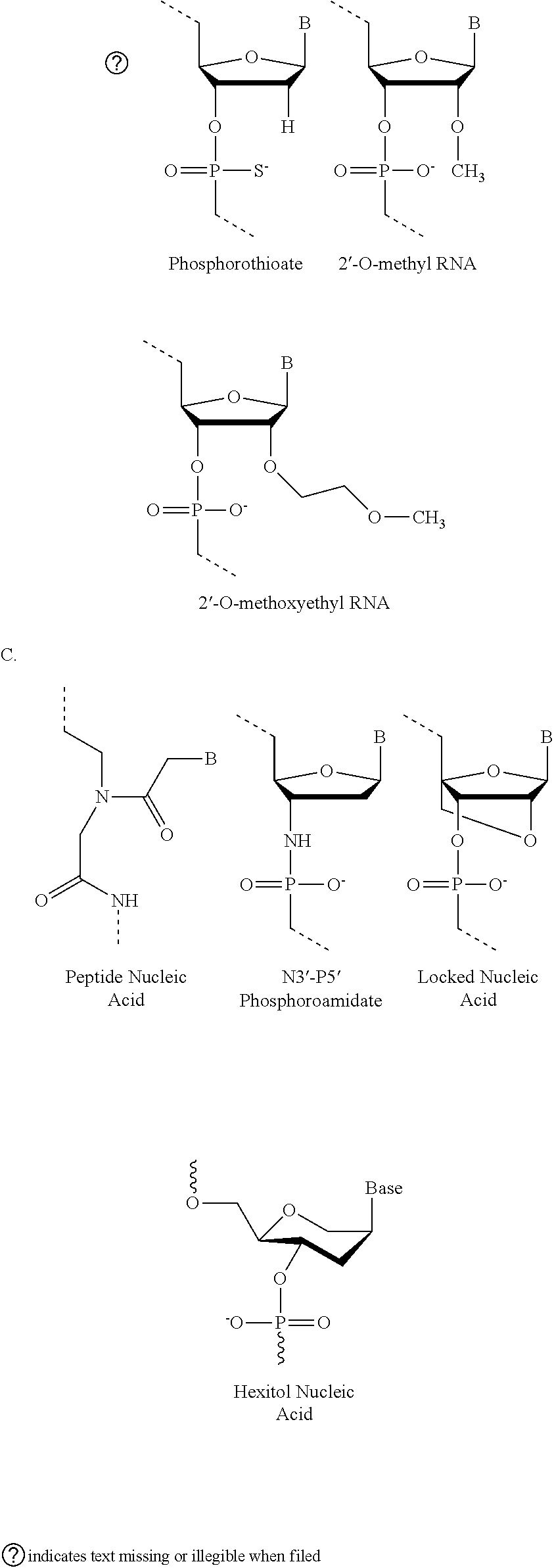Antisense conjugates for decreasing expression of dmpk
a technology of antisense conjugates and dmpk, which is applied in the direction of immunoglobulins, peptides, drugs against animals/humans, etc., can solve the problems that agents with potential therapeutic potential cannot achieve the effect in animal models or human patients, and achieve the effects of improving muscle weakness, muscle wasting, and eye damag
- Summary
- Abstract
- Description
- Claims
- Application Information
AI Technical Summary
Benefits of technology
Problems solved by technology
Method used
Image
Examples
example 1
Antisense Oligonucleotide Conjugate Synthesis
[0191]A fluorescently-labeled antisense oligonucleotide is generated in a manner similar to that described in Astriab-Fissher et al., 2002, Pharmaceutical Research, 19(6): 744-54. An antisense oligonucleotide having a sequence of SEQ ID NO: 9 is dissolved in 0.9 ml of 0.2 M Na2CO3 / NaHCO3 (pH 9.0) buffer and 90 μl of 0.2 M 5-(and 6-)-carboxytetramethylrhodamine N-hydroxysuccinimidyl ester (NHS-TAMRA, Molecular Probes) in DMSO is added. The reaction mixture is incubated in the dark at 37° C. for 4 hours and excess dye is removed by gel-filtration on a Spherilose GCL-25 (Isco, Inc.) (10×250 mm) column. The antisense oligonucleotide of SEQ ID NO: 9 could be substituted with any of the oligonucleotides having the sequences of SEQ ID NOs: 10-12 or 22-23. These oligonucleotides are exemplary of oligonucleotides within the scope of the present disclosure.
[0192]An internalizing moiety / antibody conjugate is synthesized by conjugating the fluorescen...
example 2
Uptake and Cellular Distribution of the Antisense Oligonucleotide Conjugates
[0193]Human or murine myoblasts are cultured in 100 mm dishes. 3E10-antisense oligonucleotide conjugates or free antisense oligonucleotides are mixed in Opti-MEM and incubated with the myoblasts at 37° C. for various time points (e.g., thirty minutes, one hour, three hours, six hours). After treatment with the antisense conjugates or oligonucleotides alone, the cells are removed with trypsin / EDTA and split for fluorescence microscopy or flow cytometry analysis. Half of the cells are resuspended in 1 ml 10% FBS / DMEM and incubated for 6 hours on fibronectin (10 μg / ml)-coated cover slides. The distribution of fluorescence is analyzed on a fluorescence microscope equipped for transmitted light and incident-light fluorescence analysis, with a 100-watt mercury lamp, oil immersion objective and H5546 filter. Images are captured with a slow scan charge-coupled device Video Camera System using the MetaMorph Imaging S...
example 3
In Vitro Analysis of Efficacy of Antisense Conjugates
[0194]DM1 and wildtype murine and / or human myoblasts are treated with the antisense conjugate of Example 1, the antisense oligonucleotide alone, or the 3E10 scFv polypeptide alone for various time periods (e.g., 30 minutes, 1 hour, 2 hours, 3 hours, or 4 hours). Total RNA from treated DM1 and wildtype myoblasts are purified using Trizol reagent and quantified using a spectrophotometer. To assess if treatment with the antisense conjugate results in the removal of fetal exons from DM1 myoblasts we use RTPCR employing a series of previously validated primers that coamplify fetal and adult mRNAs (Kanadia et al., 2006, Proc Natl Acad Sci USA, 103(31): 11748-53; Derossi et al., 1994, J Biol Chem, 269(14): 10444-50; Vicente et al., 2007, Differentiation, 75(5): 427-40; Yuan et al., 2007, Nucleic Acids Res, 35(16): 5474-86; Weisbart et al., 1990, J Immunol, 144(7): 2653-8; Mankodi et al., 2005, Circ Res, 97(11): 1152-5; Ashizawa et al., 1...
PUM
| Property | Measurement | Unit |
|---|---|---|
| body weight | aaaaa | aaaaa |
| pH | aaaaa | aaaaa |
| pH | aaaaa | aaaaa |
Abstract
Description
Claims
Application Information
 Login to View More
Login to View More - R&D
- Intellectual Property
- Life Sciences
- Materials
- Tech Scout
- Unparalleled Data Quality
- Higher Quality Content
- 60% Fewer Hallucinations
Browse by: Latest US Patents, China's latest patents, Technical Efficacy Thesaurus, Application Domain, Technology Topic, Popular Technical Reports.
© 2025 PatSnap. All rights reserved.Legal|Privacy policy|Modern Slavery Act Transparency Statement|Sitemap|About US| Contact US: help@patsnap.com

